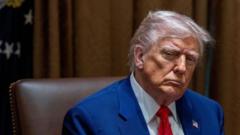In response to global economic dynamics, President Donald Trump introduced an ambitious tariff plan that threatened to disrupt longstanding trade relationships. Recently, however, the president announced a 90-day suspension of higher tariffs on most nations while intensifying a trade conflict with China. This has prompted questions about the feasibility of his tariff goals and their current status. Here’s a glance at five critical objectives Trump set forth along with an assessment of his progress.
1) **Forming Better Trade Agreements**
Originally, Trump asserted that America's trade landscape had been exploited for decades. His tariff strategy aimed at imposing a flat 10% tariff across various nations, including an additional layer for the 60 countries he deemed detrimental to the U.S. economy. This aggressive initiative prompted a global scramble for countries to negotiate concessions. Reports indicate that Trump is currently in talks with key allies such as South Korea and Japan. The imminent deadline means that both urgency and opportunity are at the forefront in the pursuit of new agreements.
2) **Revitalizing American Manufacturing**
Trump's assertion that tariffs would rebuild the U.S. manufacturing sector by protecting it from foreign competition has reverberated throughout his presidency. While some industries may momentarily increase production, ultimate growth demands stable, consistent policies. Such unpredictability in tariff application may lead businesses to adopt a "wait-and-see" stance rather than committing to expansion or investment in domestic factories.
3) **Challenging China**
Trump's ongoing confrontation with China stems from a recognition of the nation's perceived manipulation of trade. Despite this combative stance, recent statements illustrate a shift, with Trump acknowledging that previous U.S. administrations share blame for the existing trade imbalance. However, engaging in a high-stakes battle with the world’s second-largest economy brings significant risks, potentially jeopardizing alliances that could aid in this conflict.
4) **Generating Revenue**
The Trump administration projected that tariffs would yield billions, aiding in reducing the national deficit and facilitating tax cuts. Estimates suggested that a 10% tariff could generate about $2 trillion over the next decade. However, this influx could diminish if domestic production increases sufficient to reduce reliance on imports, impacting revenue streams.
5) **Lowering Consumer Prices**
A key promise of Trump's policies is that enhanced domestic production would eventually yield lower prices for consumers. However, skepticism surrounds this claim as tariffs may drive up costs; these additional expenses could be passed on to consumers. Studies show that the burden may fall disproportionately on lower-income households. Thus, while striving for a consumer-friendly policy, the reality could lead to higher living costs and discontent among voters.
As Trump navigates these complex challenges, the clock is ticking. The outcomes of his objectives may define not only his trade legacy but also his political future as he gears up for potential reelection challenges.
1) **Forming Better Trade Agreements**
Originally, Trump asserted that America's trade landscape had been exploited for decades. His tariff strategy aimed at imposing a flat 10% tariff across various nations, including an additional layer for the 60 countries he deemed detrimental to the U.S. economy. This aggressive initiative prompted a global scramble for countries to negotiate concessions. Reports indicate that Trump is currently in talks with key allies such as South Korea and Japan. The imminent deadline means that both urgency and opportunity are at the forefront in the pursuit of new agreements.
2) **Revitalizing American Manufacturing**
Trump's assertion that tariffs would rebuild the U.S. manufacturing sector by protecting it from foreign competition has reverberated throughout his presidency. While some industries may momentarily increase production, ultimate growth demands stable, consistent policies. Such unpredictability in tariff application may lead businesses to adopt a "wait-and-see" stance rather than committing to expansion or investment in domestic factories.
3) **Challenging China**
Trump's ongoing confrontation with China stems from a recognition of the nation's perceived manipulation of trade. Despite this combative stance, recent statements illustrate a shift, with Trump acknowledging that previous U.S. administrations share blame for the existing trade imbalance. However, engaging in a high-stakes battle with the world’s second-largest economy brings significant risks, potentially jeopardizing alliances that could aid in this conflict.
4) **Generating Revenue**
The Trump administration projected that tariffs would yield billions, aiding in reducing the national deficit and facilitating tax cuts. Estimates suggested that a 10% tariff could generate about $2 trillion over the next decade. However, this influx could diminish if domestic production increases sufficient to reduce reliance on imports, impacting revenue streams.
5) **Lowering Consumer Prices**
A key promise of Trump's policies is that enhanced domestic production would eventually yield lower prices for consumers. However, skepticism surrounds this claim as tariffs may drive up costs; these additional expenses could be passed on to consumers. Studies show that the burden may fall disproportionately on lower-income households. Thus, while striving for a consumer-friendly policy, the reality could lead to higher living costs and discontent among voters.
As Trump navigates these complex challenges, the clock is ticking. The outcomes of his objectives may define not only his trade legacy but also his political future as he gears up for potential reelection challenges.




















